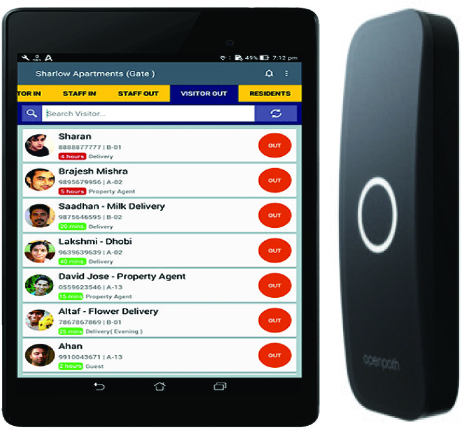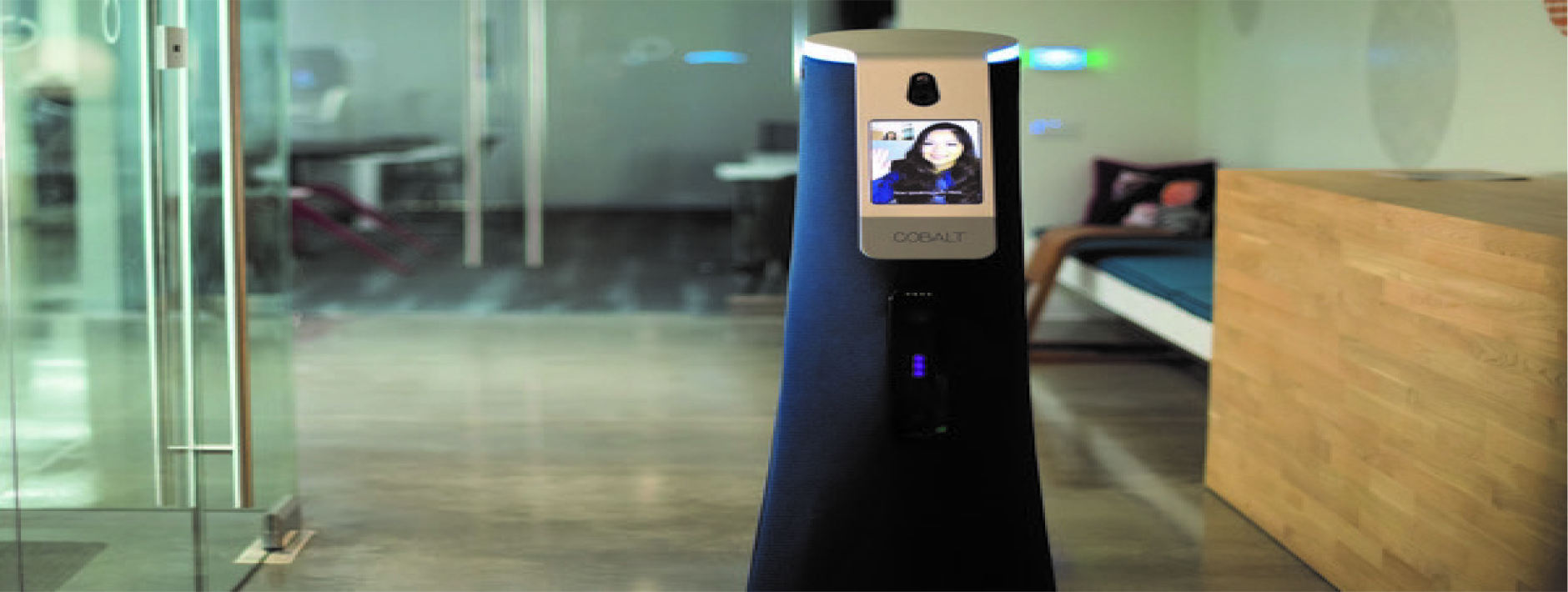
India has traditionally been a rural and agrarian society. Rapid urbanization of small towns and cities which were earlier just business centers has led to the rise of a large number of new metro and cosmopolitan cities. The technology driven solutions have now become the mainstay and USP of the concept of smart city in real estate industry. The residential societies which are like clusters of islands within a smart city have become laboratories for proliferation of such innovative technologies. The high tech residential societies within the smart city thrive and rest on tenets of continuous surveillance, monitoring, real time flow of information, and prompt response to ensure the security, safety and comfort of residents. Security indeed assumes the foremost functional criterion of these residential complexes as sustenance of any urban setup is impossible without robust security measures. To meet the challenges of growing crime and accelerating urbanization, residential societies have increasingly turned to intelligent management of security services. Connected systems that make use of new data sharing and gathering capabilities are accruing more flexibility, control and efficiency than ever before to RWAs and the service managers.
Core of security in residential society
It’s not the residential complexes only, the footprints of violence and breach of security are engulfing the canvas in an unprecedented manner everywhere – be it schools, shopping malls, metro, railways, business offices or hospitality sector. In this context, technology is a great ally to the security servers. It helps take the delinquent out of the shadows and assists in crime prevention and management of essential services. Lighting and monitoring cameras are indispensable allies in the fight against crime. The integration of technology is the key component that unites virtual reality cameras, artificial intelligence and lighting in the same equipment, and that has become the core of security and citizen engagement in every high tech residential society to subdue and defeat violence, crime, and other illegal activities besides managing services. The advent and rapid adoption of artificial intelligence (AI), IoT and shared data have turned out to be the biggest enabler to the concept of high tech residential societies. AI has empowered the security to automatically learn and detect crimes such as armed robbery, drug trafficking, bodily injury, graffiti, vandalism, parking in a prohibited place, theft of vehicles, and has equipped the RWAs with tools to manage the energy in terms of electricity, gas, water and waste. Thus the technology has provided incremental steps leading to the way we all live and work.
Benefits of SaaS based security platform
● Residents get instant notifications on their mobile phones, whenever a visitor checks in against their flat.
● Guests can be pre-entered as visitors by residents allowing them easy access to the complex.
● Residents’ can alert security guards, family and neighbors during emergencies with a button click.
● Security analytics and reports with which the management committee, society manager gets real time insights
on visitor data and trends, gets ability to check real time if set security processes are followed.
● Complete visitor management, domestic staff management, association staff attendance with evidence, smart
ID for residents/ staff, panic alert for residents, material in/ out tracking (for example, water tanker/ diesel/
pump for repair), automatic gate pass printing – every aspect needed by modern apartment complexes for
their security is being custom-built by gate keeper.
Mobile access controls
In the first half of 2019, we have seen unprecedented integrations into security systems. Examples include access control systems using biometrics such as face recognition systems, smart phones to grant entry, and autonomous robots roaming in lobbies and corridors after working hours.

Mobile access controls have grown in popularity because of the personalized experience it offers to the tenants. Everybody is going to use and access this space at different times and different ways. You really have to make sure that you have the technology to support. If this is something that sounds like the right fit for your building, then make sure your facility has strong internet and cellphone signals. Consider boosting the cellphone signals in your area to ensure seamless connectivity across the cloud, Wi-Fi and cellular.

Mobile access controls have grown in popularity because of the personalized experience it offers to the tenants. Everybody is going to use and access this space at different times and different ways. You really have to make sure that you have the technology to support. If this is something that sounds like the right fit for your building, then make sure your facility has strong internet and cellphone signals. Consider boosting the cellphone signals in your area to ensure seamless connectivity across the cloud, Wi-Fi and cellular.
Access control systems have greatly evolved over the years – and some of the companies that produce them are taking advantage of the universality of the smartphone. Open path’s access control reader is such a device that allows tenants to use their smartphone to gain entry. The process is completely keyless and hands-free.
Autonomous robots
They might sound like the stuff of sci-fi movies, but mobile autonomous robots are becoming increasingly inexpensive and accessible.

The biggest impediment to the robot as a security option is cultural. So, to make sure that people know what a robot is, what it can do, and how it benefits them is really important for installing these systems. Unlike cameras and access controls, having this mobile robot moving through the space is such a visible thing in your premises. It changes people’s behavior in the most exciting ways – the aim is to marry the best parts of the machine with the best parts of people.
The intelligent security robots combine sophisticated sensors – including day-night cameras, thermal sensors and motion sensors – with the ability to connect remotely to a system specialist who appears via video chat. That allows someone to gather information in context and provide that intelligence and insight to the authorities. An autonomous security robot can outperform static building infrastructure and complement any Internet of Things device already in place. When you think about smart buildings, you will see a robot and the services it provides as a part of those buildings.
Smart water meters
The most useful feature of the smart meter is the real-time water usage data it provides. This ensures that people are aware of the amount of water they consume, leading to more cautious utilization. The water meter, which consists of a data logger that runs on in-built software, allows residents to track the consumption of water in their household through a mobile application called ‘Water On.’ Apart from churning out data and displaying monthly water bills, the app raises an alert via an SMS whenever there is a leakage in the faucet. This way, the person can immediately act on it and save water.

With a smart water meter installed, SVR Samruddhi, a housing society apartment complex situated at Electronic City in Bengaluru, was paying Rs.38,000 per month to get water tankers. But now, it has brought this spend down to Rs.31,000, thanks to the smart water meters installed across 30 apartments in the complex. The results were almost instantaneous. In a span of two months, there is a reduction in water consumption by over 60 percent.
Tap aerators
A tap aerator is a simple device that can be fixed at the mouth of a faucet or inside the spout. The device, which comes with a mesh screen, splits the flow of water into multiple small streams by adding air in between, which results in reducing the volume of water flowing from the tap. Aerators are very light on the pocket, and are available in India in the range of Rs.150 to Rs.650.

Water aerators regulate the flow of water in taps. Bhondve Empire, a residential colony located in Ravet, Pune, was able to save a substantial amount of water after tap aerators were fixed in 114 flats in August 2018.
Connected lighting
Connected lighting systems that offer remote monitoring and intelligent management of all light points across a residential society or a smart city can serve as agents of change, making lighting operations much more efficient and environment-friendly while enhancing the cultural and social life of the residents, and cultivating a sense of security and peace of mind. Connected light ing systems give street lighting managers the ability to specifically target and optimize light levels and distribution in different areas of a residential society. When lighting brightly illuminates a street at night, eliminating dim sidewalks and dark corners, pedestrians feel more relaxed and engaged. When lanes and intersections are properly illuminated, driving becomes a pleasure with less confusion and fewer accidents. Intelligently managed lighting can enrich a residential society’s identity and cultural life. Beautifully illuminated lanes, facades, club house, gym, swimming pool, parks and shops are the spaces that invite people to enjoy their premises at night, supporting commerce and encouraging people to attend cultural events and special celebrations, both indoors and outdoors. Dynamic lighting experiences can join with thoughtful functional lighting to strengthen the sense of community within the four walls of the residential society.
The future is all about connected lighting, which will be at the heart of high-tech residential societies and smart cities of 2030. By the time, about 60% of people will live in cities and there will be close to 70 billion light points in the world. Many of these light points will be connected – by sensor nodes in networks capable of acquiring, sending and receiv ing data. All this because public lighting is already available, has its own power source and offers a dense network of connection points – it is an ideal infrastructure to support your city’s future IoT strategy. An open API will allow connected lighting to be integrated into your other city management systems and allows your existing partners or independent third parties to use it as a platform for future innovation and following benefits at large.
Energy optimization
With full control of society’s lighting you can identify opportunities for further energy savings by dimming, scheduling and zoning that enables you to reduce CO2 emissions, meet sustainability targets and reduce costs, enabling you to reinvest the savings into other areas of infrastructure.
Scene management
The ‘connected lighting’ concept enables residential societies to use its lighting infrastructure to support commerce and improve life for residents. Scene management is used to give parks, plazas and other landmarks a unique identity by lighting them in memorable and engaging ways, enabling the city lighting operator to program and manage dynamic light shows on one or multiple installations.
Lighting asset management
This concept remotely manages and monitors the premises entire lighting system in real-time via one dashboard, with an additional scope to monitor the energy consumption, thus immediately identifying and locating any faults, and then trigger work orders and plan maintenance schedules.
Environmental monitoring
Highly granular environmental data such as temperature, moisture and noise from streets and parks can be collected, extracted, stored and contextualized by Interact City connected lighting system and then used for city planning strategies. Light on demand strategies designed around adapting light levels to the density of people or movement in the street bring further opportunities to make lighting investments more sustainable and optimize use of resources.
Incident detection
Incident detection uses sensors on light poles to monitor and alert emergency services when unexpected traffic sounds or crowd noise is detected. Sharing real-time data over the connected lighting system means you can respond to disturbances quickly and accurately. Over time, data collection supports predictive analytics, which helps in reducing crime and traffic accidents to create a greater sense of security in premises. Outdoor lighting and IT are very different industries. Creating working systems that are part of both worlds is only possible through continuous software adaptation and delivery.
Video analytics
Video surveillance has established itself as a stalwart in the realm of security technology. Today’s systems come with features that almost sound unbelievable. Thanks to the combination of sensors and machine learning algorithms that have given cameras which can recognize an individual’s gait, detect and display thermal patterns. As the cameras themselves become more sophisticated, so too will be the ways in which the data can be analyzed. We expect to see more intelligent and accurate video analytics that can bring together multiple video sources.
Conclusion
With these innovative technologies available at the door step, RWAs have pushed off a lot of the administrative burden of managing something like an access system to residents themselves. RWAs can also be catalytic in saving the national resources like water and power. With video analytics, support is being extended to law and order maintenance agencies like police in reduction of crime. However it’s important to be aware of the types of technology that are coming down the pike, and how existing technologies are becoming more integrated and sophisticated to reinforce cyber and physical security measures to add value and keep the residents safe, secure and in comfort zone.

